1. 二维曲线
plot函数&fplot函数
Plot函数
(1)plot函数的基本用法
plot(x,y)
其中,x与y分别用于存储x坐标与y坐标数据
例1:绘制一条折线
>> x = [2.5, 3.5, 4, 5];
>> y=[1.5, 2.0, 1, 1.5];
>> plot(x,y)
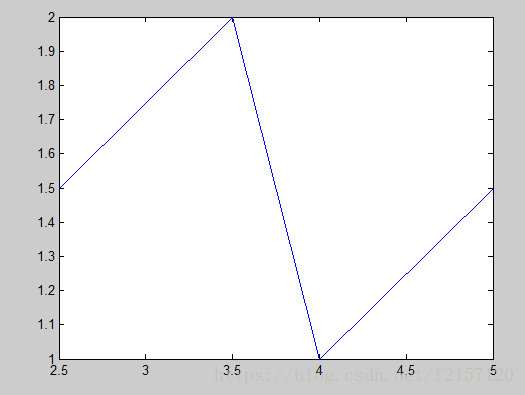
(2)最简单的plot函数调用方式
>> x=[1.5, 2.0, 1, 1.5];
>> plot(x)
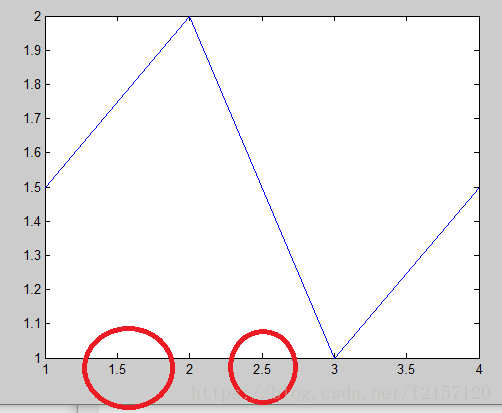
当plot函数的参数x是复数向量时,则分别以该向量元素实部与虚部为横纵坐标绘制一条曲线
>> x = [2.5, 3.5, 4, 5];
>> y=[1.5, 2.0, 1, 1.5];
>> cx = x + y*i; //cx = complex(x,y)
>> plot(cx)
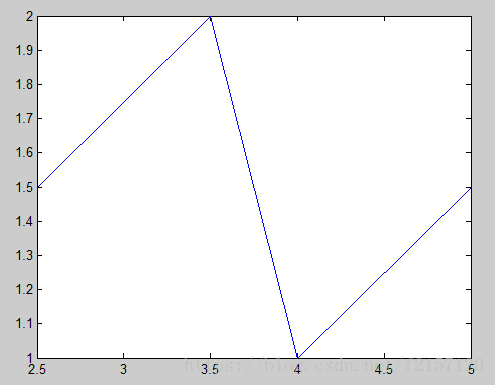
(3)plot(x,y)函数参数的变化形式
- 当x是向量,y是矩阵时
如果矩阵y的列数等于向量x的长度,则以向量x为横坐标,y的每个行向量为纵坐标绘制曲线,曲线的条数等于y的行数
如果矩阵y的行数等于向量x的长度,则以向量x为横坐标,y的每个列向量为纵坐标绘制曲线,曲线的条数等于y的列数
例2:绘制sin(x),sin(2x),sin(0.5x)的曲线
>> x = linspace(0,2*pi,100);
>> y = [sin(x);sin(2*x);sin(0.5*x)];
>> plot(x,y)

-当x,也是同型矩阵时
则以x,y对应列元素为横纵坐标分别绘制曲线,曲线条数等于矩阵的列数
>> t = 0:0.01:2*pi;
>> t1 = t';
>> x = [t1, t1, t1];
>> y = [sin(t1),sin(2*t1),sin(0.5*t1)];
>> plot(x,y)
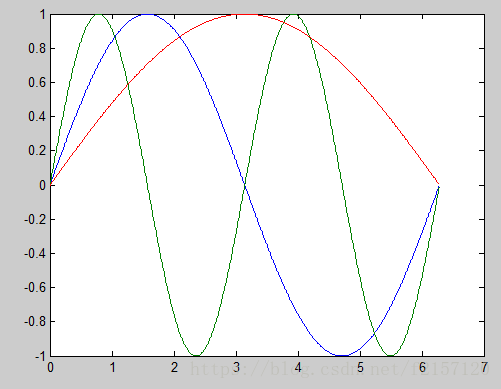
(4)含多个输入参数的plot函数
plot(x1,y1,x2,y2,...,xn,yn)
其中每一向量构成一组数据点的横纵坐标,绘制一条曲线
例3 采用不同数据点绘制正弦曲线,观察曲线的形态
>> t1 = linspace(0,2*pi,10);
>> t2 = linspace(0,2*pi,20);
>> t3 = linspace(0,2*pi,100);
>> plot(t1,sin(t1),t2,sin(t2)+1,t3,sin(t3)+2)
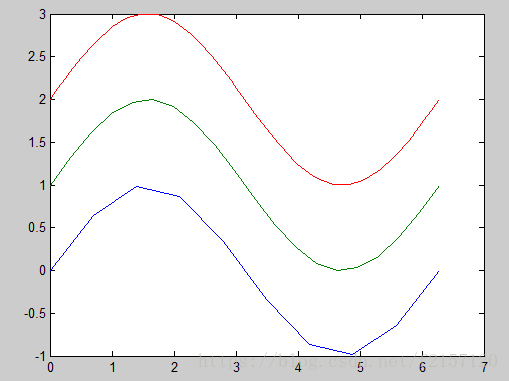
(5)含选项的plot函数
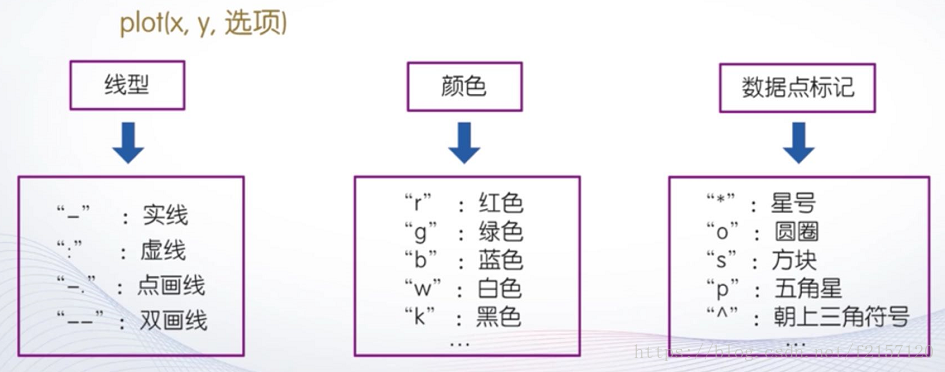
例4:用不同线形和颜色在同一坐标内绘制曲线y=2exp(-0.5x)*sin(2*pi*x)及其包络线
>> x=(0:pi/50:2*pi)';
>> y1 = 2*exp(-0.5*x)*[1,-1];
>> y2 = 2*exp(-0.5*x).*sin(2*pi*x);
>> x1 = 0:0.5:6;
>> y3 = 2*exp(-0.5*x1).*sin(2*pi*x1);
>> plot(x,y1,'k:',x,y2,'b--',x1,y3,'rp')
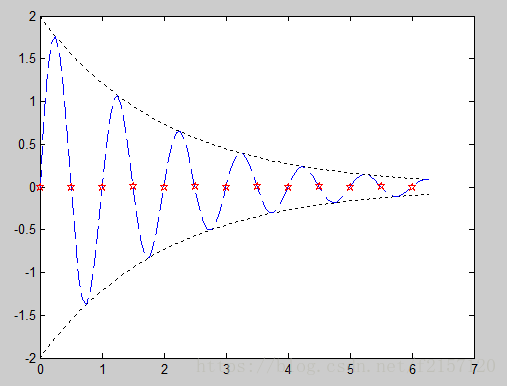
fplot函数
例5:绘制sin(1/x)的图形
>> x = 0:0.005:0.2;
>> y=sin(1./x);
>> plot(x,y)
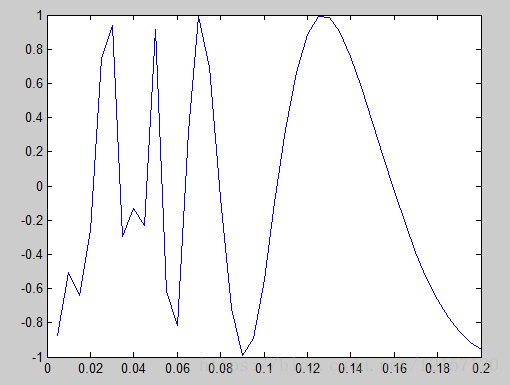
(1)fplot函数基本用法
fplot(f,lims,选项)
其中,f代表一个函数,通常采用函数句柄的形式,lims为x轴的取值范围,用二元向量(xmin,xmax)描述,默认值为【-5,5】,选项定义与plot函数相同
例6:用fplot绘制sin(1/x)的图形
>> fplot(@(x)sin(1./x),[0,0.2],'b')
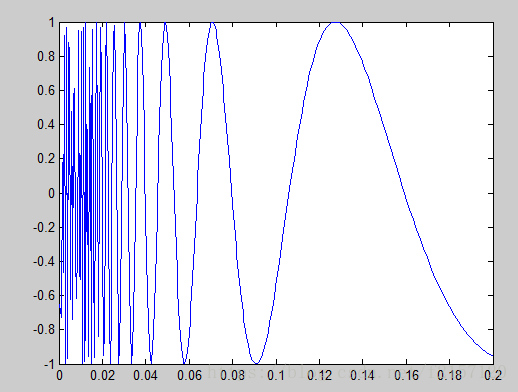
相比较plot函数,fplot会自动缩放坐标轴,避免丢失剧烈变化的细节信息。
(2)双输入函数参数的用法
fplots(funx,funy,tlims,选项)
其中,funx,funy代表函数,通常采用函数句柄的形式,tlims为参数funx,funy的自变量的取值范围,用二元向量[tmin,tmax]描述
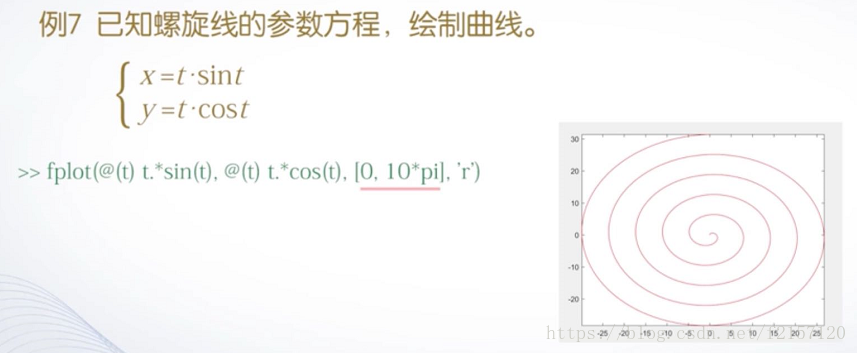
2.绘制图形的辅助操作
给图形添加标注
坐标控制
图形保持
图形窗口的分割
> Title(图形标题)
> xlable(x轴说明)
> ylable(y轴说明)
> text(x,y图例说明)
> legend(图例1,图例2,……)
(1)title函数
例1 绘制[-2pi, 2pi]区间的正弦曲线并给图形添加标题
>> x=-2*pi:0.01:2*pi;
>> y=sin(x);
>> plot(x,y)
>> title('y=sin(x)')
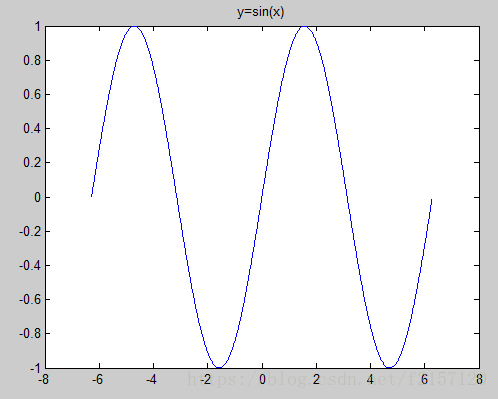
在图形标题中使用LaTeX格式控制符
>> title('y=cos{\omega}t')
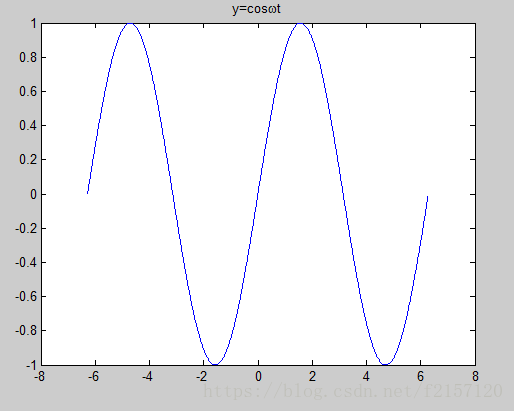
>> title('y=e^{axt}')
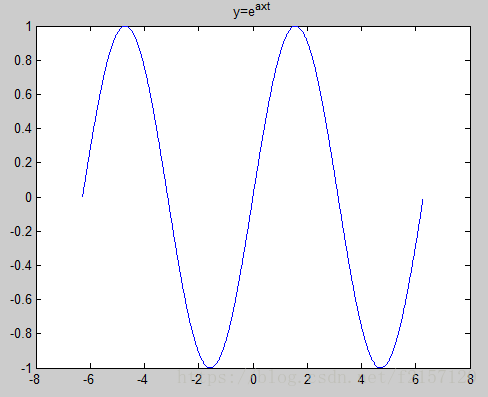
>> title('X_{1}{\geq}X_{2}')
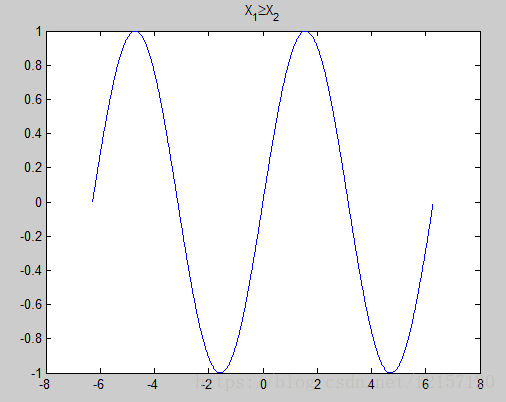
>> title('{\bf y=cos{\omega}t +{\beta}}')
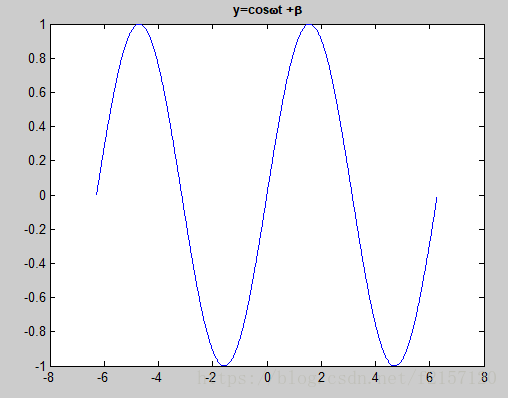
“\bf”: 加粗
“\it”:斜体
“\rm”:正体
含属性设置的title函数
Title(图形标题,属性名,属性值)
> color属性:用于设置图形标题文本的颜色
>>title('y=cos{\omega}t','Color','r')

> FontSize属性:用于设置标题文字的字号/默认字号为11
title('y=cos{\omega}t','FontSize',24)
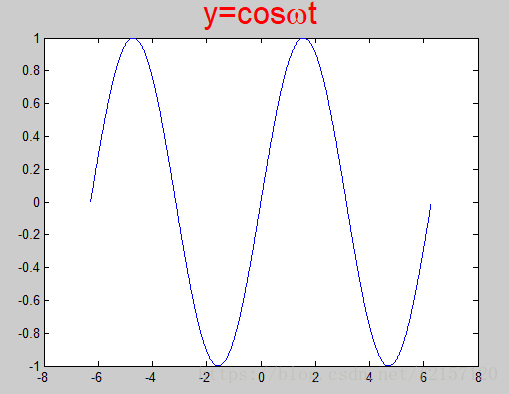
(2)xlabel函数和ylabel函数
Xlabel(x轴说明)
ylabel(y轴说明)
>> x = -2*pi:0.05:2*pi;
>> y = sin(x);
>> plot(x,y)
>> title('y=sin(x)')
>> xlabel('-2\pi \leq x \leq 2\pi')
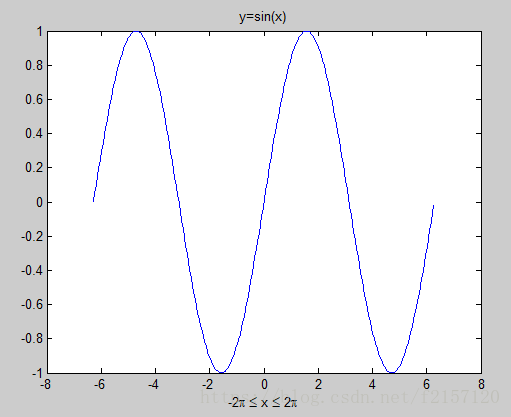
(3)text函数和gtext函数
Text(x,y,说明)
Gtext(说明)
>> text(-2*pi, 0,'-2{\pi}')
>> text(3, 0.28,'\leftarrow sin(x)')
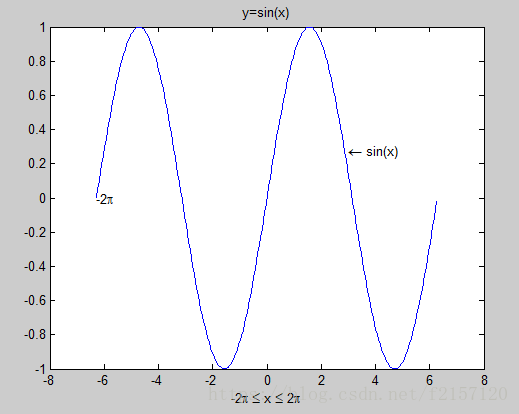
(4)legend函数
Legend(图例1,图例2,……)
例2 绘制不同频率的正弦曲线,并用图例标出曲线。
>> x = linspace(0,2*pi,100);
>> plot(x,[sin(x);sin(2*x);sin(3*x)])
>>legend('sin(x)','sin(2x)','sin(3x)')
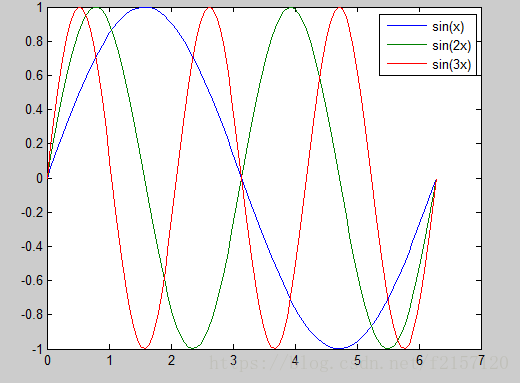
坐标控制
(1)axis函数
Axis的其他用法
Axis equal: 横、纵坐标采用等长刻度
Axis square:产生正方形坐标系,默认为矩形
Axis auto:使用默认设置
Axis off:取消坐标轴
Axis on:显示坐标轴
>> x = [0, 1, 1, 0, 0];
>> y = [0, 0, 1, 1, 0];
>> plot(x,y)
>> axis([-0.1, 1.1, -0.1, 1.1])
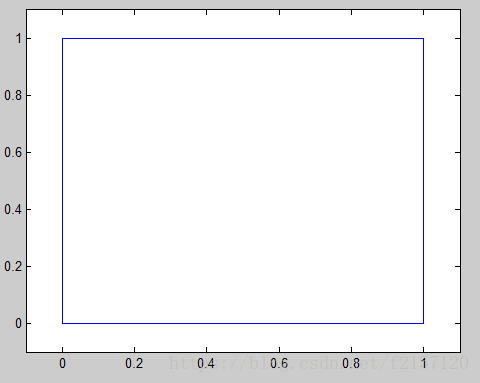
>> axis equal;

(2)给坐标加网格和边框
Grid on
Grid off
Grid 交互的打开,关闭网格
Box on
Box off
Box
例3:绘制sin(x),sin(2x),sin(x/2)的函数曲线并添加图形标注
>>x=linspace(0,2*pi,100);
>> y=[sin(x);sin(2*x);sin(0.5*x)];
>> plot(x,y)
>> axis([0,7,-1.2,1.2])
>> title('different frequency sinewave');
>> xlabel('Variable X');
>> ylabel('Variable Y');
>> text(2.5,sin(2.5),'sin(x)');
>> text(1.5,sin(2*1.5),'sin(2x)');
>>text(5.5,sin(0.5*5.5),'sin(0.5x)');
>>legend('sin(x)','sin(2x)','sin(0.5x)');
>> grid on
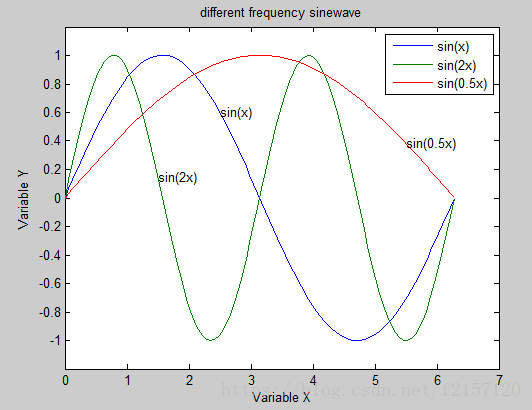
图形保持
Hold on
Hold off
Hold
例4:用图形保持功能绘制两个同心圆
>> t=linspace(0,2*pi,100);
>> x=sin(t);
>> y=cos(t);
>> plot(x,y,'b')
>> hold on;
>> plot(2*x,2*y,'r--')
>> grid on
>> axis([-2.2,2.2,-2.2,2.2])
>> axis equal
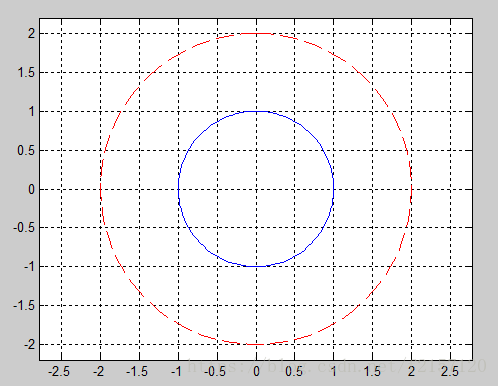
图形窗口的分割
子图:同一个图形窗口中不同坐标系下的图形
Subplot函数,subplot(m,n,p)
其中,m和n指定将图形窗口分成m x n个绘图区,p指定当前活动区 默认排序为按行排序。
>> subplot(2,2,1);
>> x=linspace(0,2*pi,60);
>> y=sin(x);
>> plot(x,y);
>> title('sin(x)');
>> axis([0,2*pi,-1,1]);
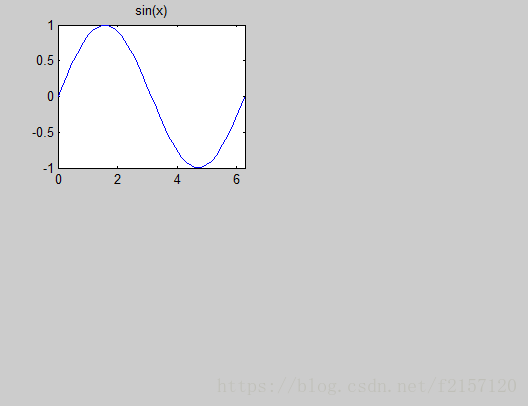
>> x=linspace(0,2*pi,60);
>> subplot(2,2,1);
>> plot(x,sin(x)-1);
>> title('sin(x)-1');
>> axis([0,2*pi,-2,0]);
>> subplot(2,1,2);
>> plot(x,cos(x)+1);
>> title('cos(x)+1');
>> axis([0,2*pi,0,2]);
>> subplot(4,4,3);
>> plot(x,tan(x));
>> title('tan(x)');
>> axis([0,2*pi,-40,40]);
>> subplot(4,4,8);
>> plot(x,cot(x));
>> title('cot(x)');
>> axis([0,2*pi,-35,35]);
>>
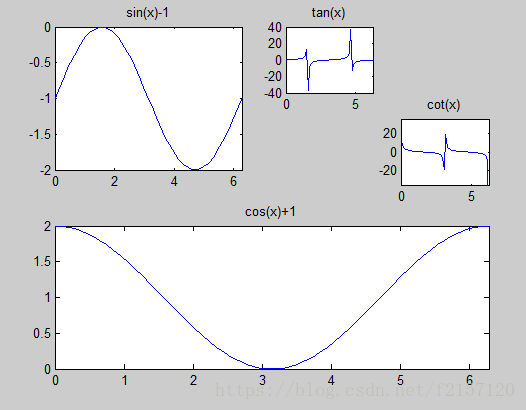
其它坐标系下的二维曲线
统计图
矢量图形
(1)对数坐标图
Semilogx(x1,y1,选项1,x2,y2,选项2,……)
Semilogy(x1,y1,选项1,x2,y2,选项2,……)
loglog(x1,y1,选项1,x2,y2,选项2,……)
例1:绘制1/x的直角线坐标图和三种对数坐标图
>>x=0:0.1:10;
>> y=1./x;
>> subplot(2,2,1);
>> plot(x,y);
>> title('plot(x,y)');
>> subplot(2,2,2);
>> semilogx(x,y);
>> title('semilogx(x,y)');
>> grid on
>> subplot(2,2,3);
>> semilogy(x,y);
>> title('semilogy(x,y)');
>> grid on
>> subplot(2,2,4);
>> loglog(x,y);
>> title('loglog(x,y)');
>> grid on
>>
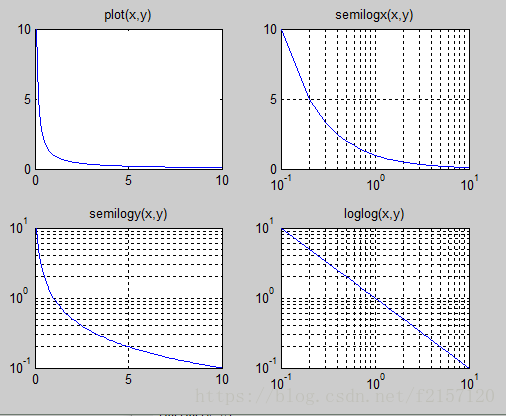
(2)极坐标图
Polar(theta,rho,选项)
其中,theta为极角,rho为极径,选项的内容与plot函数相同
例2:按极坐标方程rho = 1-sin(theta)绘制心形曲线
>> t=0:pi/100:2*pi;
>> r=1-sin(t);
>> subplot(1,2,1);
>> polar(t,r);
>> subplot(1,2,2);
>> t1 = t-pi/2;
>> r1 = 1-sin(t1);
>> polar(t,r1)
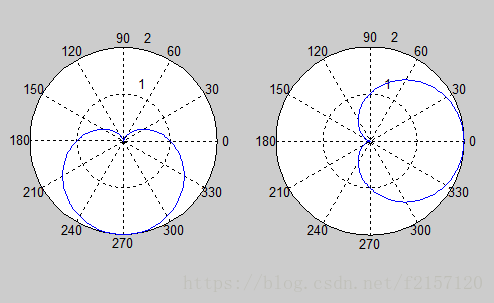
统计图
条形图
直方图
饼图
散点图
(1)条形类图形
条形图:bar函数,barh函数
Bar函数:bar(y,style) “grouped”:簇状分组; “stacked”:堆积分组
其中,参数y是数据,选项style用于指定分组排列模式
例3:绘制分组条形图
>>y=[1,2,3,4,5;1,2,1,2,1;5,4,3,2,1];
>> subplot(1,2,1);
>> bar(y);
>> title('Group');
>> subplot(1,2,2);
>> bar(y,'stacked');
>> title('Stack');
>> y
y =
1 2 3 4 5
1 2 1 2 1
5 4 3 2 1
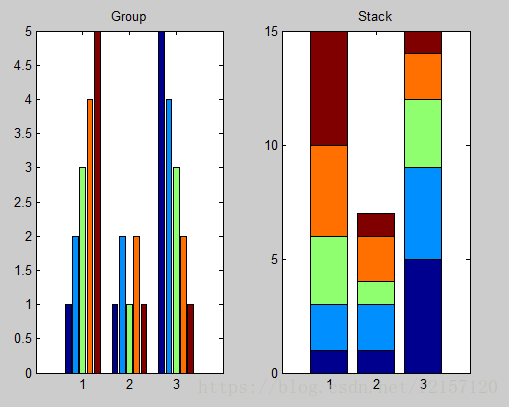
bar函数:bar(x,y,style),其中x存储横坐标,y存储数据
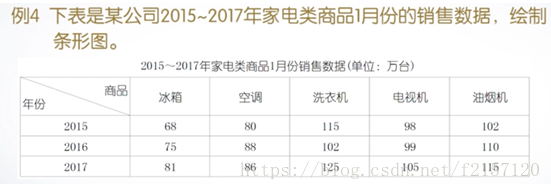
>> x=[2015,2016,2017];
>> y=[68,80,115,98,102;75,88,102,99,110;81,86,125,105,115];
>> bar(x,y);
>> title('Group');
>>
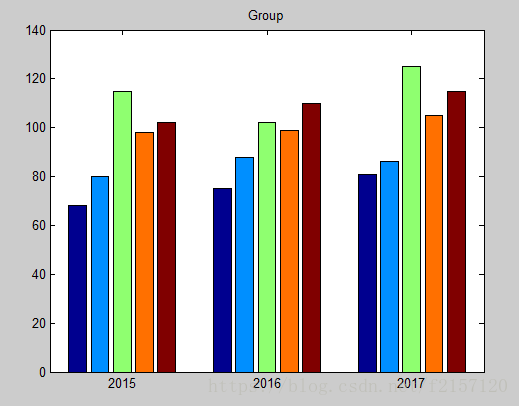
直方图:hist函数,rose函数
Hist函数:
hist(y)
hist(y,x)
其中,参数y是要统计的数据,x用于指定区间的划分方式
例5:绘制服从高斯分布的直方图
>>y=randn(500,1);
>> subplot(2,1,1);
>> hist(y);
>> title('Gauss Histgram');
>> subplot(2,1,2);
>> x=-3:0.2:3;
>> hist(y,x);
>> title('Histgram with designatedarea center');
>>
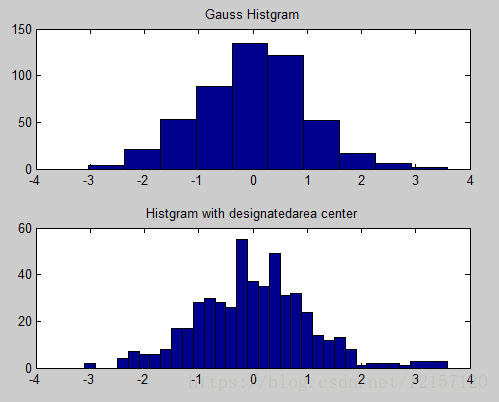
Rose函数:rose(theta,x)
其中,参数theta用于确定每一区间与原点的角度,选项x用于指定区间的划分方式
例6:绘制高斯分布数据在极坐标系下的直方图
>> y=randn(500,1);
>> theta=y*pi;
>> rose(theta);
>> title('Histgram under rose');
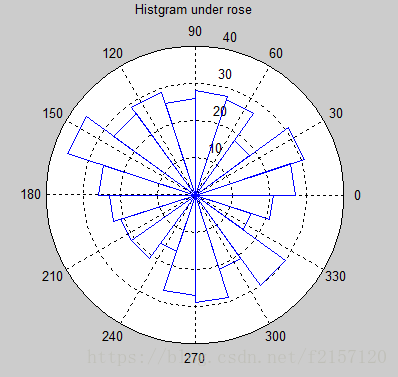
(2)面积类图形
Pie函数、area函数
Pie(x,explode)
其中,参数x存储待统计的数据,选项explode控制图块的显示方式
例7:某次考试优秀,良好,中等,及格,不及格的人数分别为:5,17,23,9,4,试用扇形统计图作成绩统计分析
>>score = [5,17,23,9,4];
>> ex = [0,0,0,0,1];
>> pie(score,ex)
>>legend('A','B','C','D','E','location','eastoutside')
>>
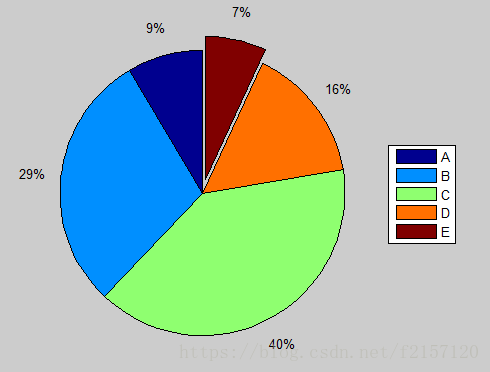
(3)散点类图形
Scatter函数:散点图
Staris函数:阶梯图
Stem函数:杆图
例8 以散点图的形式绘制桃心曲线,曲线的参数方程如下:
X=16sin^3(t)
Y=13cos(t)-5cos(2t)-2cos(3t)-cos(4t)
>> t = 0:pi/50:2*pi;
>> x=16*sin(t).^3;
>>y=13*cos(t)-5*cos(2*t)-2*cos(3*t)-cos(4*t);
>> scatter(x,y,'r','filled')
>>
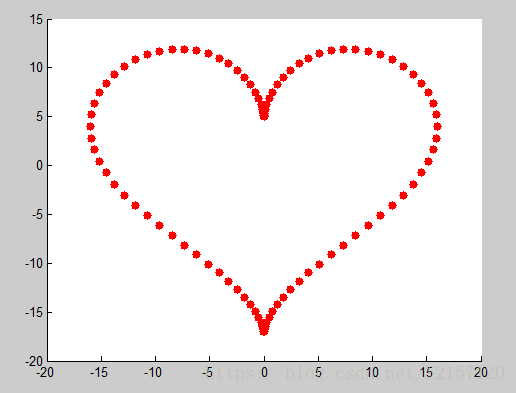
矢量类图形
Compass函数:罗盘图
Feather函数:羽毛图
Quiver函数:箭头图
Quiver函数的调用格式:quiver(x,y,u,v),其中,(x,y)指定矢量期间,(u,v)指定矢量终点
例9 已知向量A,B,求A+B,并用矢量图表示
>>A=[4,5];
>> B=[-10,0];
>> C=A+B;
>> hold on
>> quiver(0,0,A(1),A(2));
>> quiver(0,0,B(1),B(2));
>> quiver(0,0,C(1),C(2));
>> text(A(1),A(2),'A');
>> text(B(1),B(2),'B');
>> text(C(1),C(2),'C');
>> axis([-12,6,-1,6])
>> grid on
>>
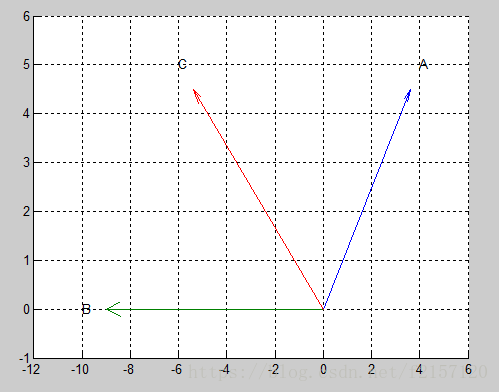
4.三维曲线
Plot3函数
Fplot3函数
(1)plot3函数的基本用法 plot3(x,y,z)
其中,参数x,y,z组成一组曲线的坐标
例1 绘制一条空间折线
>> x=[0.2,1.8,2.5];
>> y=[1.3,2.8,1.1];
>> z=[0.4,1.2,1.6];
>> plot3(x,y,z)
>> grid on
>> axis([0,3,1,3,0,2]);
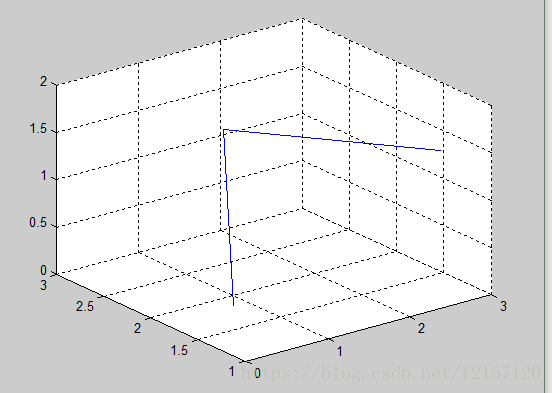
例2 绘制螺旋线x=sin(t) + t*cos(t);y=cos(t)-t*sin(t);z=t, (0 <= t <= 10*pi)
>> t=linspace(0,10*pi,200);
>> x=sin(t)+t.*cos(t);
>> y=cos(t)-t.*sin(t);
>> z=t;
>> subplot(1,2,1);
>> plot3(x,y,z);
>> grid on
>> subplot(1,2,2);
>> plot3(x(1:4:200),y(1:4:200),z(1:4:200));
>> grid on
>>
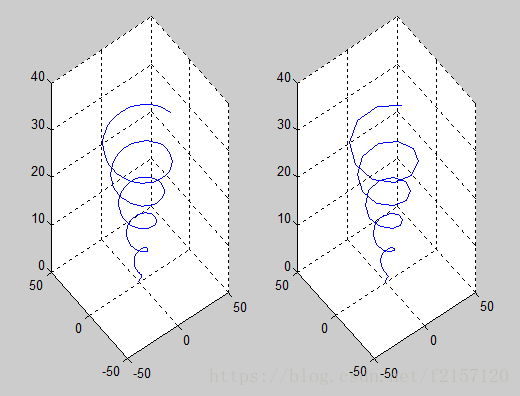
(3)plot3函数参数的变化形式
Plot3(x,y,z)
参数x,y,z是同型矩阵
参数x,y,z中有向量,也有矩阵
例3 在空间不同位置绘制5条正弦曲线
>> t = 0:0.01:2*pi;
>> t=t';
>> x=[t,t,t,t,t];
>>y=[sin(t),sin(t)+1,sin(t)+2,sin(t)+3,sin(t)+4];
>> z=[t,t,t,t,t];
>> plot3(x,y,z)
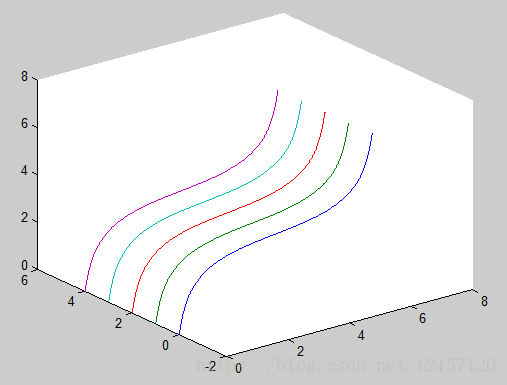
(3)含多组输入参数的plot3函数
Plot3(x1,y1,z1,x2,y2,z2,...,xn,yn,zn)
每一组x,y,z向量构成一组数据点的坐标,绘制一条曲线
例4 绘制三条不同长度的正弦曲线
>>t = 0:0.01:1.5*pi;
>> t1 = 0:0.01:1.5*pi;
>> t2 = 0:0.01:2*pi;
>> t3 = 0:0.01:3*pi;
>>plot3(t1,sin(t1),t1,t2,sin(t2)+1,t2,t3,sin(t3)+2,t3)
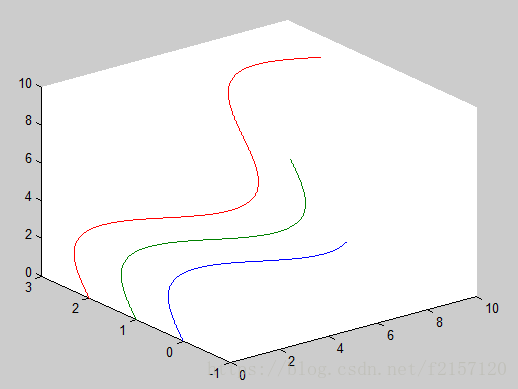
例5 绘制空间曲线x=cos(t);y=sin(t); z=2*t, (0 <= t <=6*pi)
>> t =0:pi/50:6*pi;
>> x=cos(t);
>> y=sin(t);
>> z=2*t;
>> plot3(x,y,z,'r');
>> xlabel('X');
>> ylabel('Y');
>> zlabel('Z');
>> grid on
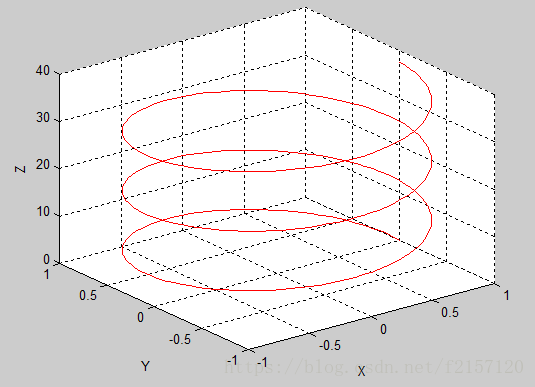
Fplot3(funx,funy,funz,tlims)
其中,funx,funy,funz代表定义曲线x,y,z坐标的函数,通常采用函数句柄的形式。Tlims为参数函数自变量的取值范围,用二元向量[tmin, tmax]描述,默认为[-5, 5]
例6 绘制墨西哥帽顶曲线,曲线参数方程如下
X=exp(-t/10)*sin(5*t);
Y=exp(-t/10)*cos(5*t); [-12 <= t <=12]
Z=t;
>> xt = @(t)exp(-t/10).*sin(5*t);
>> yt = @(t)exp(-t/10).*cos(5*t);
>> zt = @(t)t;
>> fplot3(xt,yt,zt,[-12,12])
>> fplot3(xt,yt,zt,[-12,12],'r-')
5. 三维曲面
平面网格数据的生成
绘制三维曲面的mesh函数和surf函数
Fmesh函数和fsurf函数
平面网格数据的生成
(1)利用矩阵运算生成
>> x=2:6;
>> y=(3:8)';
>> X=ones(size(y))*x;
>> Y=y*ones(size(x));
(2)利用meshgrid函数生成
[X,Y]=meshgrid(x,y);
其中,参数x,y为向量,存储网格点坐标的X,Y为矩阵
>> x=2:6;
>> y=(3:8)';
>> [X,Y]=meshgrid(x,y);
例1 绘制空间曲线
>> x=2:6;
>> y=(3:8)';
>> [X,Y]=meshgrid(x,y);
>> Z=randn(size(X));
>> plot3(X,Y,Z);
>> grid on
>>

绘制三维曲面的函数
Mesh(x,y,z,c)
Surf(x,y,z,c)
其中,x,y是网格坐标矩阵,z是网格点上的高度矩阵,c用于指定在不同高度下的曲面颜色
例2 绘制三维曲面图z=x*exp(-x^2 - y^2)
>> close all
>> t=-2:0.2:2;
>> [X,Y]=meshgrid(t);
>> Z=X.*exp(-X.^2-Y.^2);
>> subplot(1,3,1);
>> mesh(X,Y,Z);
>> subplot(1,3,2);
>> surf(X,Y,Z);
>> subplot(1,3,3);
>> plot3(X,Y,Z);
>> grid on
>>
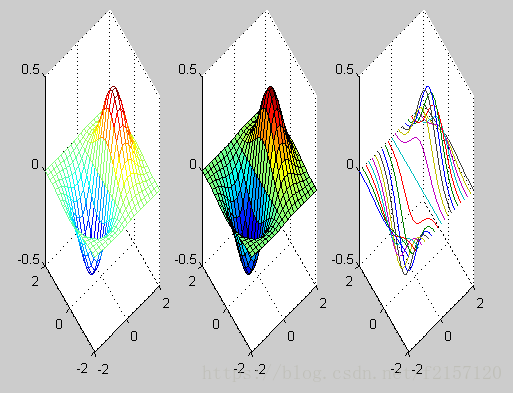
Mesh函数和surf函数的其他调用格式:
Mesh(z,c)
Surf(z,c)
当x,y省略时,z矩阵的第2维下标当作x轴坐标,z矩阵的第1维下标当作y轴坐标
>> t=1:5;
>> z=[0.5*t;2*t;3*t];
>> mesh(z);
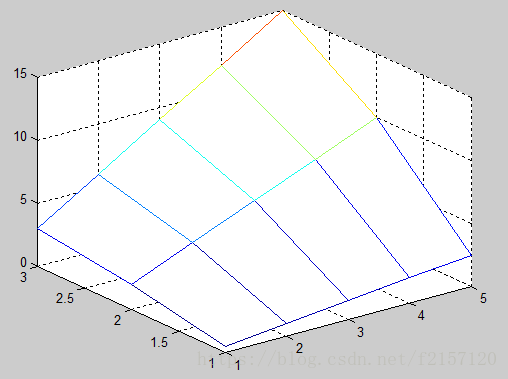
绘制三维曲面的函数
带等高线的三维网格曲面函数meshc
带底座的三维网格曲面函数meshz
具有等高线的曲面函数surfc
具有光照效果的曲面函数surfl
例3 用4种方法绘制函数z=(x-1)^2 +(y-2)^2 -1的曲面图,其中[0<= x <= 2],[1 <=y <= 3]
>> [x,y]=meshgrid(0:0.1:2,1:0.1:3);
>> z=(x-1).^2 + (y-2).^2 -1;
>> subplot(2,2,1);
>> meshc(x,y,z);
>> title('meshc(x,y,z)');
>> subplot(2,2,2);
>> meshz(x,y,z);
>> title('meshz(x,y,z)');
>> subplot(2,2,3);
>> surfc(x,y,z);
>> title('surfc(x,y,z)');
>> subplot(2,2,4);
>> surfl(x,y,z);
>> title('surfl(x,y,z)');
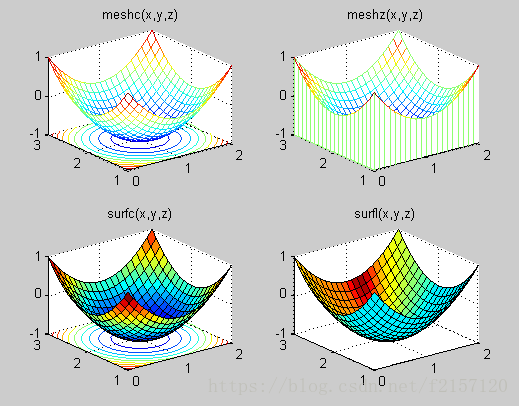
标准三维曲面
(1)sphere函数
[x,y,z]=sphere(n)
(2)cylinder函数
[x,y,z]=cylinder(R,n)
例4 用cylinder函数分别绘制柱面,花瓶和圆锥面
>> subplot(1,3,1);
>> [x,y,z]=cylinder;
>> surf(x,y,z);
>> subplot(1,3,2);
>> t=linspace(0,2*pi,40);
>> [x,y,z]=cylinder(2+cos(t),30);
>> surf(x,y,z);
>> subplot(1,3,3);
>> [x,y,z]=cylinder(0:0.2:2,30);
>> surf(x,y,z);
>>
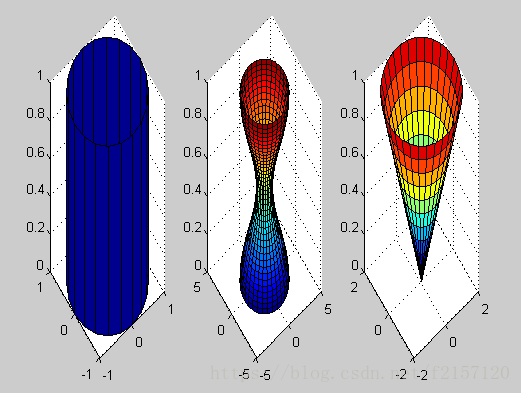
例5 用cylinder函数绘制两个相互垂直且直径相等的圆柱面的相交图形
>> [x,y,z]=cylinder(1,60);
>> z=[-1*z(2,:);z(2,:)];
>>surf(x,y,z);
>>hold on
>>surf(y,z,x);
>>axis equal
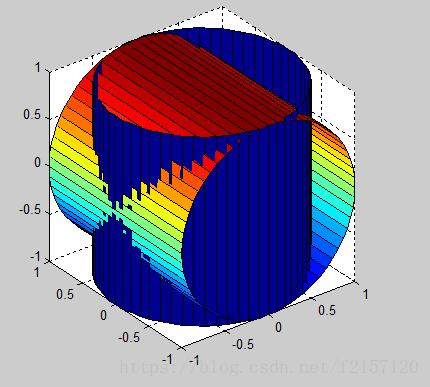
(3)peaks函数
多峰函数
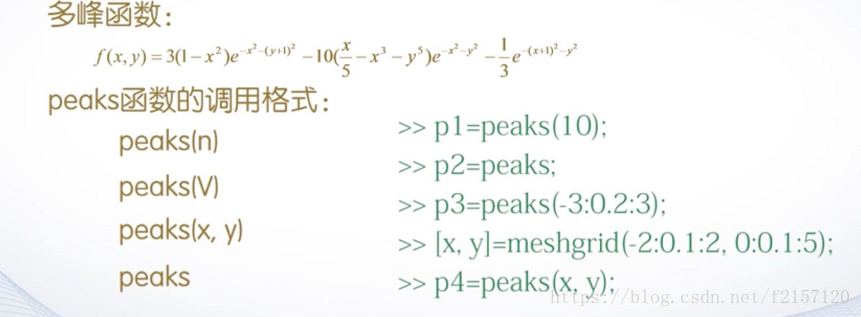


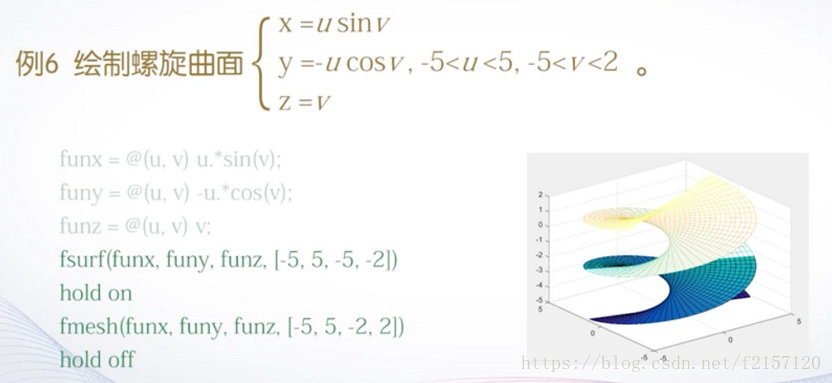
6, 图形的修饰处理
视点处理
色彩处理
裁剪处理
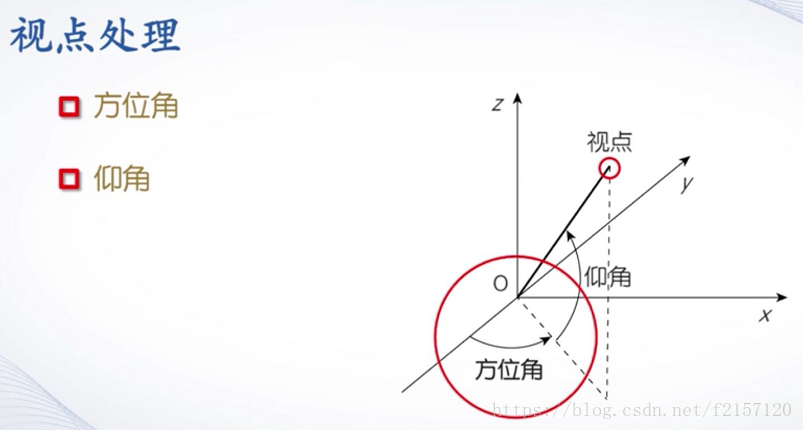
(1)view函数的基本用法
view(az,el)
其中,az为方位角,el为仰角
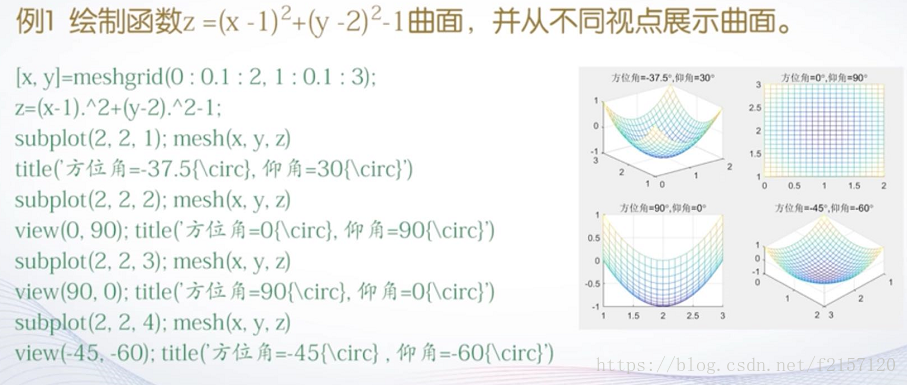
(2)view函数的其它用法
view(x,y,z)
view(2)
view(3)

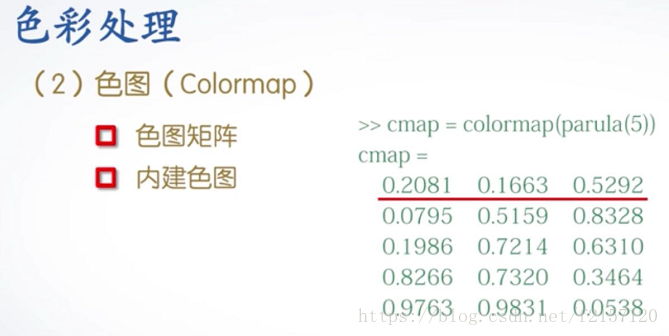
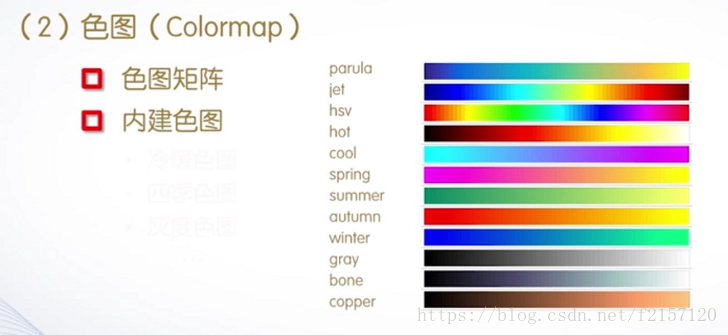
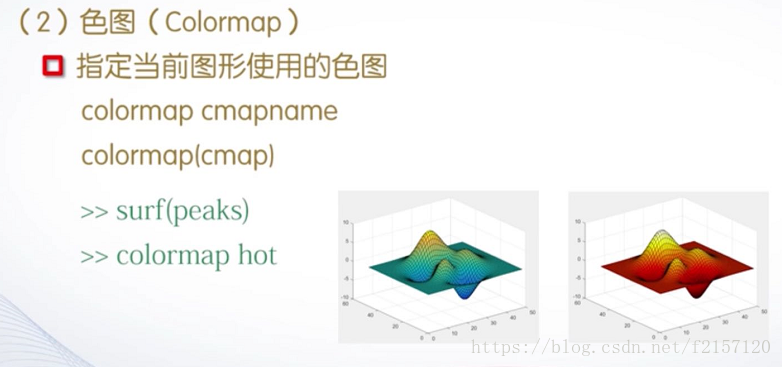

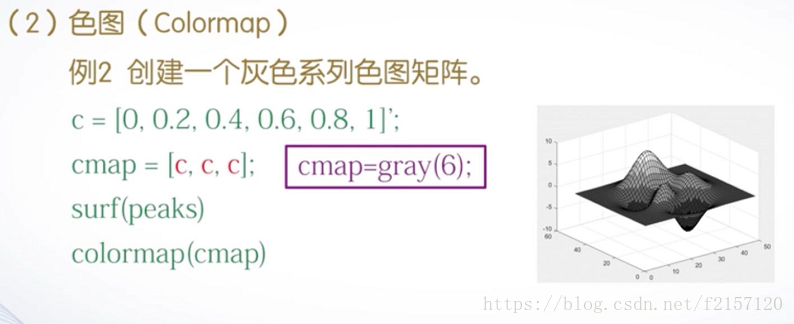
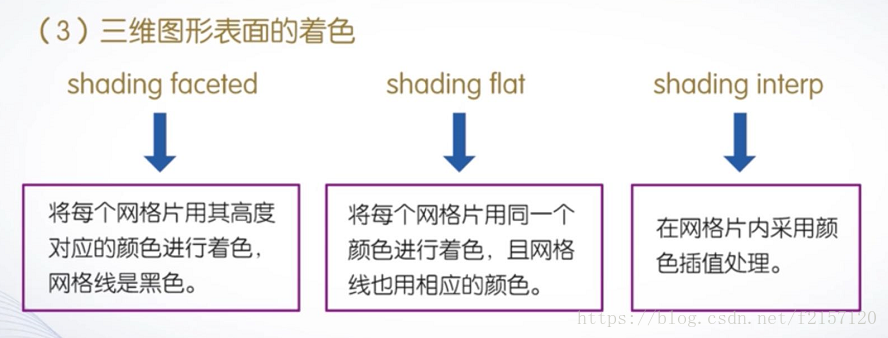
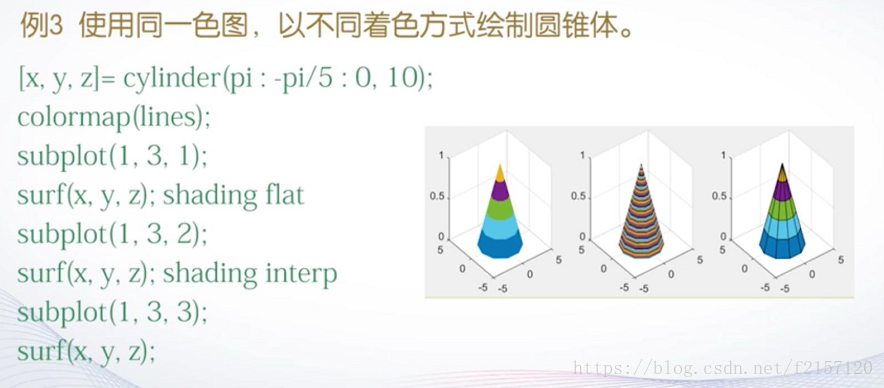


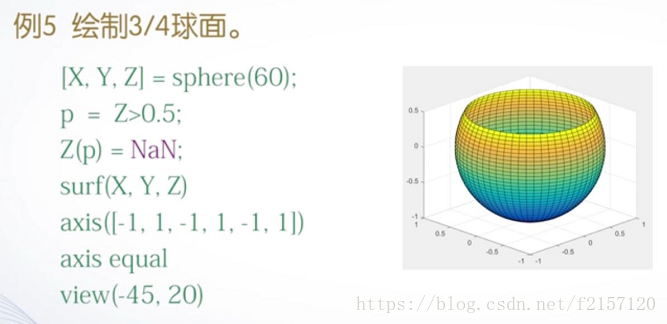








 本文详细介绍了Matlab中二维及三维图形的绘制方法,包括曲线、曲面、统计图等多种类型的图表绘制技巧,并提供了丰富的实例代码。
本文详细介绍了Matlab中二维及三维图形的绘制方法,包括曲线、曲面、统计图等多种类型的图表绘制技巧,并提供了丰富的实例代码。
















 429
429

 被折叠的 条评论
为什么被折叠?
被折叠的 条评论
为什么被折叠?








